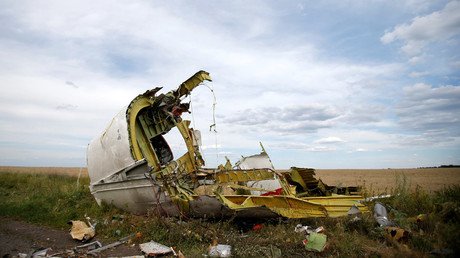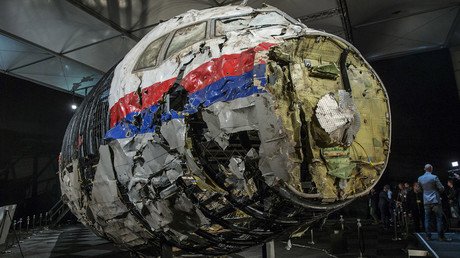MH17 tragedy: Key questions remain unanswered as int’l probe enters 4th year
Three years after Malaysia Airlines Flight MH17 crashed in Ukraine, crucial questions about the tragedy remain unanswered as international investigators are tied to dubious theories and seem to pay little attention to data provided by Russia.
This Monday marks three years since Flight MH17 crashed in July 2014 in eastern Ukraine amid hostilities between Ukrainian troops and anti-government paramilitary forces who rejected the Western-backed coup in Kiev earlier that year.
The tragedy killed all 298 people on board, eventually leading to an international inquiry carried out by a Joint Investigation Team (JIT) comprising aviation experts and investigators from the Netherlands, Belgium, Australia, Malaysia and Ukraine.
However, the investigators are still unable to reach firm conclusions and establish hard facts. They have also failed to name a single suspect, reducing hope that the truth will ever be found at all.
Western media have frequently pinned the blame for the tragedy on the rebels and, ultimately, on Russia – even though the JIT repeatedly failed to demonstrate convincing evidence to back up preliminary conclusions about the crash.
Missile type
The JIT concluded that the Malaysia Airlines Boeing 777 was hit by a mid-range missile launched from a Buk air defense system located in area controlled by anti-government forces. The JIT also concluded that the launcher was transported across the border from Russia.
Investigators cited satellite imagery said to have tracked the launcher, as well as open source information, including user-generated videos and social media entries.
Last year, Almaz-Antey, the Buk manufacturer, staged a real-time experiment to examine the impact the claimed missile would have had on the airliner. The mock test revealed major inconsistencies in the JIT theory as the manufacturer concluded that the missile claimed to have brought down the plane is no longer in use with the Russian military.
Almaz-Antey also said the weapon that brought down the plane was likely fired from Kiev-controlled territory.
However, the international team opted to use a “similar” US-made missile to model the impact, though Almaz-Antey insisted it differs significantly from the Buk in critical features, including flight path and other properties.
#MH17 crash: #Russia ready to help #Netherlands decode 'primary data' https://t.co/S1E25F7a9apic.twitter.com/eS1JmwjE4K
— RT (@RT_com) February 19, 2017
Russian radar data neglected
The investigation paid little attention to comprehensive data provided by Russian authorities, which agreed to hand over all sensitive information in attempts to reach a full understanding of what had happened in July 2014 in Ukrainian airspace.
In autumn last year, Russia’s aviation authority, Rosaviatsia, provided radar data showing that no missile approached the aircraft on the day of the crash. In January, the Dutch authorities responded by saying they were unable to decipher the data as it came in an “unusual format.”
Though Russia explained that it had used the ASTERIX format to present the raw data, the Dutch claimed the Russian radar was incapable of spotting a relatively small object the size of a missile. Oleg Storchevoy, head of Rosaviatsia, dismissed the claim by saying the radar station can detect much smaller objects than a Buk missile.
“If a projectile was moving along the trajectory described in the version of ‘launch on a head-on course,’ as the Dutch party claims, its flight time would be about 35 seconds,” the official said. Accordingly, the radar would register at least two or three clear ticks, he added.
While the MH17 black box data indicates that the tragedy took place at 13:20:03 GMT, the radar last registered the aircraft at 13:20:01.87, less than a second and a half before the disaster, Storchevoy said.
Impartiality concerns
Moscow has long voiced concerns over impartiality in the investigation. Despite uneven indications on Russian involvement in the crash, Moscow has been given only limited opportunities to contribute to the fact-finding effort.
Last year, Russian aviation authorities presented new criticism of the Dutch handling of the MH17 investigation and the low quality of its “vague” final report on the crash.
Storchevoy accused Dutch investigators of studying social media posts instead of performing a forensic examination of the crash site, an approach he dubbed “unprecedented.” The aviation official said that once the investigators did arrive, they did not conduct on-the-spot experiments in order to determine the exact sequence of events.
The Dutch also refused to cooperate with Almaz-Antey, lodging only a single enquiry with the arms manufacturer, and did not visit Russia, despite numerous offers to do so, he added.
“I think there is almost no hope to get answers to the bulk of questions we have because of this tragic accident,” Willy Wimmer, former vice president of the Parliamentary Assembly of the Organization for Security and Cooperation in Europe (OSCE), told RT.
He also found it strange that questions remain over the fate of two Malaysian flights – MH17 and MH370, which went missing over the South China Sea in March 2014.
“It doesn’t fit in the experience of [investigating into] air accidents we have in Europe – I won’t mention the other parts of the world,” he said, noting the inquiry into the crash of Germanwings Flight 9525.
In that case, investigators knew the crash was deliberately caused by the co-pilot, Andreas Lubitz, “within days,” Wimmer added. He underlined there should have been another investigation in the case of MH17, run by a body “less politicized than we have today.”














